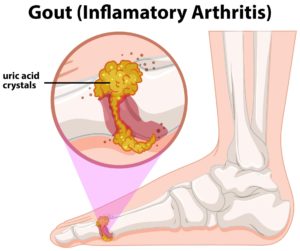
Few studies have looked at the link between gout and comorbidities among females. This led researchers to investigate men and women further to determine the different transition trajectories and the occurrence of stroke. Men and women were followed from 2000 to 2009 to identify comorbidities of heart disease, diabetes, high blood pressure, hyperlipidemia, and chronic kidney disease.
The study looked at 2,780 patients with gout – 965 being women and 1,815 being men.
During the 10-year follow-up, both men and women with gout had five risk cluster transition (CT) phenotypes; CT1 and CT2, with various persistent comorbidities; CT3, with few persistent comorbidities; and CT4 and CT5, with transfer to cluster 1 from other clusters. Women in CT2 had mainly diabetes and had a significantly higher risk of stroke.
Higher risk of stroke was seen among women in CT2 and CT4. Women in these clusters had the highest risk of stroke within the 10-year follow up period.
The researchers concluded that the findings could help provide clinical awareness concerning early assessment and management of gout-related comorbidities among women.




